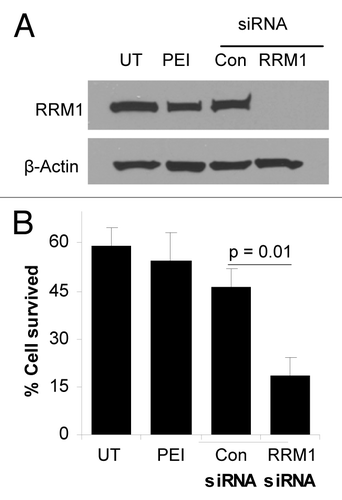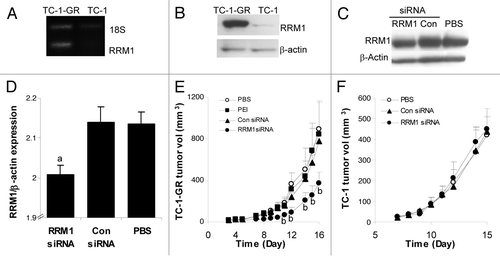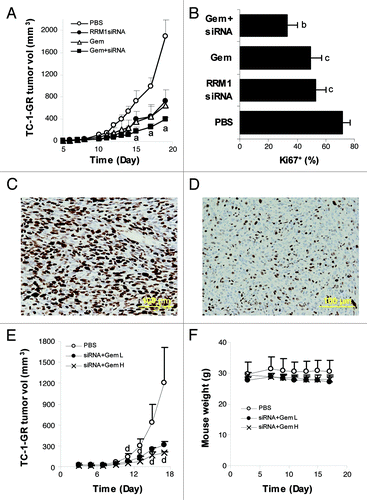Figures & data
Figure 1. RRM1-specific siRNA downregulated RRM1 expression and sensitized TC-1-GR tumor cells to gemcitabine. (A) Immunoblotting analysis of RRM1 in untransfected TC-1-GR cells (UT) or TC-1-GR cells transfected with PEI-RRM1 siRNA or PEI-control siRNA complexes. As a control, cells were also treated with PEI25K alone (PEI). (B) Cytotoxicity of gemcitabine in TC-1-GR cells transfected with PEI-RRM1 siRNA or PEI-control siRNA complexes. Data are presented as a mean ± SEM (n = 3).

Figure 2. Systemic administration of RRM1-specific siRNA downregulated RRM1 expression in TC-1-GR tumors in mice and significantly inhibited TC-1-GR tumor growth. (A–B) RT-PCR (A) and immunoblotting (B) analyses of RRM1 expression in TC-1 and TC-1-GR tumor tissues 21 d after tumor cell injection. (C–D) Immunoblotting analysis of RRM1 expression in TC-1-GR tumors after mice were treated with PEI-RRM1 siRNA complexes. TC-1-GR tumor cells were injected (s.c.) in female nude mice on day 0. Mice were injected with PEI-siRNA complexes (0.5 mg/kg siRNA per mouse per injection) every two days for two consecutive weeks, starting on day 7. a The level of RRM1 protein in tumors in mice that were treated with the PEI-RRMi siRNA complexes was significantly lower than that in tumors in mice that were treated with the PEI-control siRNA complexes or PBS. (E-F) RRM1-specific siRNA inhibited the growth of TC-1-GR tumors (E), but not TC-1 tumors (F) in mice. Tumors were injected in mice on day 0. TC-1-GR tumor-bearing mice were injected with PEI-RRM1 siRNA or PEI-control siRNA complexes on days 3–5, 7–12, and 14–16. TC-1 tumor-bearing mice were injected on days 7–11 once daily. The dose of the siRNA was 0.5 mg/kg per mouse per injection. b The values of the RRM1 siRNA group were significantly different from that of the control siRNA group (p < 0.05). Data are presented as a mean ± SEM (n = 2–3 in D, 3–5 in E-F).

Figure 3. RRM1-specific siRNA sensitized TC-1-GR tumors to gemcitabine in a mouse model. (A) The antitumor activities of RRM1 siRNA, gemcitabine (Gem), or RRM1 siRNA in combination with gemcitabine (siRNA+Gem) in mice with pre-established TC-1-GR tumors. TC-1-GR tumor cells were injected in nude mice on day 0. On days 5–8, 10–15, and 17, mice were injected with PEI-siRNA complexes (0.5 mg/kg siRNA per mouse per injection). On days 5, 8, 11, 14, and 16, mice were injected with gemcitabine HCl (150 mg/kg per mouse per injection). aThe values of the Gem+siRNA were significantly different from that of the Gem alone or siRNA alone (p < 0.05). (B) Proliferation indices of TC-1-GR tumor cells after different treatments. bThe value of Gem+siRNA was significantly different from that of the Gem alone or siRNA alone. c The values of the Gem alone and siRNA alone were significantly different from that of the PBS (p < 0.05). (C-D) Typical pictures (magnification: 20 x) of TC-1-GR tumor tissues stained against Ki67 cell proliferation marker after mice were treated with PBS (C) or RRM1 siRNAs in combination with gemcitabine (D) (bar = 100 μm). (E) The effect of the dose of gemcitabine on the antitumor activity of RRM1-specific siRNA and gemcitabine combination therapy against TC-1-GR tumors in mice. TC-1-GR tumor cells were injected in nude mice on day 0. On days 3–8 and 10–16, mice were injected with PEI-siRNA complexes. On days 3, 6, 9, 12, and 16, mice were injected with gemcitabine HCl. The dose of siRNA and gemcitabine HCl were 0.5 mg/kg and 150 mg/kg per mouse per injection, respectively, for the siRNA+Gem L group, 1 mg/kg and 300 mg/kg per mouse per injection, respectively, for the siRNA+Gem H group. d The values of siRNA+Gem H and siRNA+Gem L were significantly different (p < 0.05). Data are presented as a mean ± SEM (n = 4–5) in A, B, and E. (F) The body weights of mice treated in (E).
